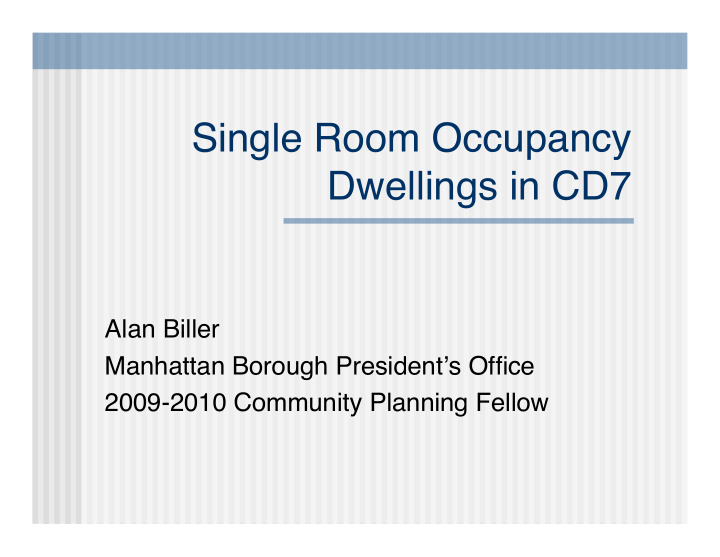



Single Room Occupancy Dwellings in CD7 Alan Biller Manhattan Borough President ’ s Office 2009-2010 Community Planning Fellow
Guiding Questions What are SRO units and why are they important? How many SRO units in CD7? How many SRO units have we lost? How are SRO units used? How many are used as tourist hotels? How many are used for city social service placement?
What are SROs? Single Room Occupancy units Bathroom and kitchen outside unit Section 248 of Multiple Dwelling Law Mid- to long-term housing Generally considered lowest level of housing HPD classifies as “B” units
Benefits and Drawbacks of SROs Benefits of SROs Prevent homelessness Increases variety of housing stock Provides workforce housing Drawbacks of SROs Concentrates poverty and social problems Building conditions Harassment related to alternate uses
Breakdown of SROs in CD7 13,364 “B” units, includes: Hotels Student Housing Servant ’ s quarters in luxury buildings Non-profit supportive housing Traditional SROs
As of 2008, market-driven SROs made up an estimated 8.1% of rental housing stock.
Lost SRO Units At least 1,997 units lost 1,336 lost since 1996 Local Law 19 and Certificates of Non- Harassment Many SRO buildings converted to one- and two-family homes
Lost SRO Units Difficult to determine number of lost units At least 31 buildings with substantial work permits and NO NEW C of O Many buildings with no C of O at all HPD Registration and Violation Database out of date
Non-Profit SROs 1,957 units in 17 buildings WSFSSH Goddard Riverside Volunteers of America Lantern Organization On-site supportive services Recent renovations
Illegal Hotels Estimated between 1,700 and 3,500 “B” units used for illegal hotels Up to 57% of market driven SRO units Difficult to determine exact numbers or define “illegal hotels”
Problems With Illegal Hotels Drives out long-term tenants Nuisance to long-term tenants Safety concerns - fire codes and egress Damaging to tourism industry
Illegal Hotels - Classification No consistent classification for hotels/SROs Multiple Dwelling Law Class A - long-term use (30 days or more) Class B - short-term use 1968 Building Code J-1 - short-term J-2 - long-term Not consistently found on C of O 2008 Building Code R-1 - short term, including hotels R-2 - long term, including apartment hotels
Illegal Hotels - Classification Department of Finance H classification for hotels Tax purposes Zoning Resolution Apartment hotels permitted in residential zoned area Transient hotels NOT permitted in residential zoned area, only in commercial Transient Use not defined in any statute How long constitutes “permanent residency”
Illegal Hotels - Classification 34 alleged illegal hotel buildings 22 Class A Multiple Dwelling, 2 Class B Multiple Dwelling, 10 unknown One J-1 classification, no J-2 21 with H classification for DOF 9 in commercially zoned area, 25 in residential
Legal v. Illegal Hotels - Examples Jazz on the Park, 34 W. 106th Street Class B Hotel, J-1, H9, zoned R8 Jazz on the Park Annex, 54 W. 105th Street Old Law Tenement/SRO, C of O says “residential,” DOF class C4, zoned R8B Excelsior Hotel, 45 W. 81st Street HPD: 98 A units, 69 B units, C of O says “Class A Apartment/Hotel,” DOF class H9, zoned R10A, impressive website WHICH OF THESE ARE ILLEGAL??
City of New York v. 330 Continental LLC The Continental, The Montroyal, The Pennington Stallman Decision - Enjoined defendants from using building for short-term rental Overturned by appellate division Multiple Dwelling Law: Class A Multiple Dwelling defined as “occupied, as a rule , for permanent residence purposes” Zoning Resolution: Apartment Hotels defined as buildings in which “dwelling units or rooming units are used primarily for permanent occupancy” Court ruled that buildings could have secondary use up to 50% of units
Proposed Legislation - Gottfried and Krueger Clarifies occupancy rules for Class A Multiple Dwellings Eliminates terms “as a rule” and “primarily” from MDL and zoning resolution Requires occupancy by natural person - no more corporate occupancy Allows exceptions for roommates and short-term use at discretion of occupant (vacations, etc.) Provides opportunity for illegal hotels operating since prior to 1968 to obtain updated Certificate of Occupancy
City Placement Nine buildings Up to 1,019 units Short term Government subsidies DHS - Housing Stability Plus (HSP) HRA - HIV/AIDS Services Administration (HASA) Also long-term supportive housing placement
Problems With City Placements Drives out long-term tenants, creates nuisance Building conditions issues Use of buildings for city placement and illegal hotel Illegal use of subsidies - continuing to receive subsidies while forcing out HSP/HASA tenants
Recommendations Work to develop more supportive housing with on-site services Encourage upgrade of “B” units without displacement of tenants Provide incentives to keep SROs viable using partnerships with non-profits Improve government agency record- keeping and SRO classification
Recommendations - Illegal Hotels and City Placements Pass proposed illegal hotel legislation Improve enforcement and increase fines Consider independent hotels bureau and certification process Prevent city placement into buildings with multiple housing code violations
Recommend
More recommend